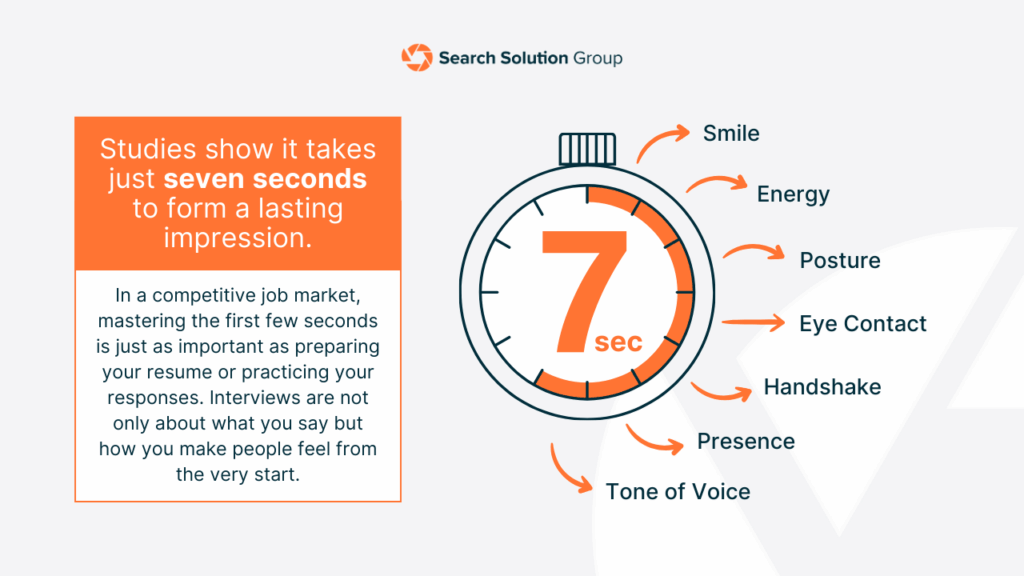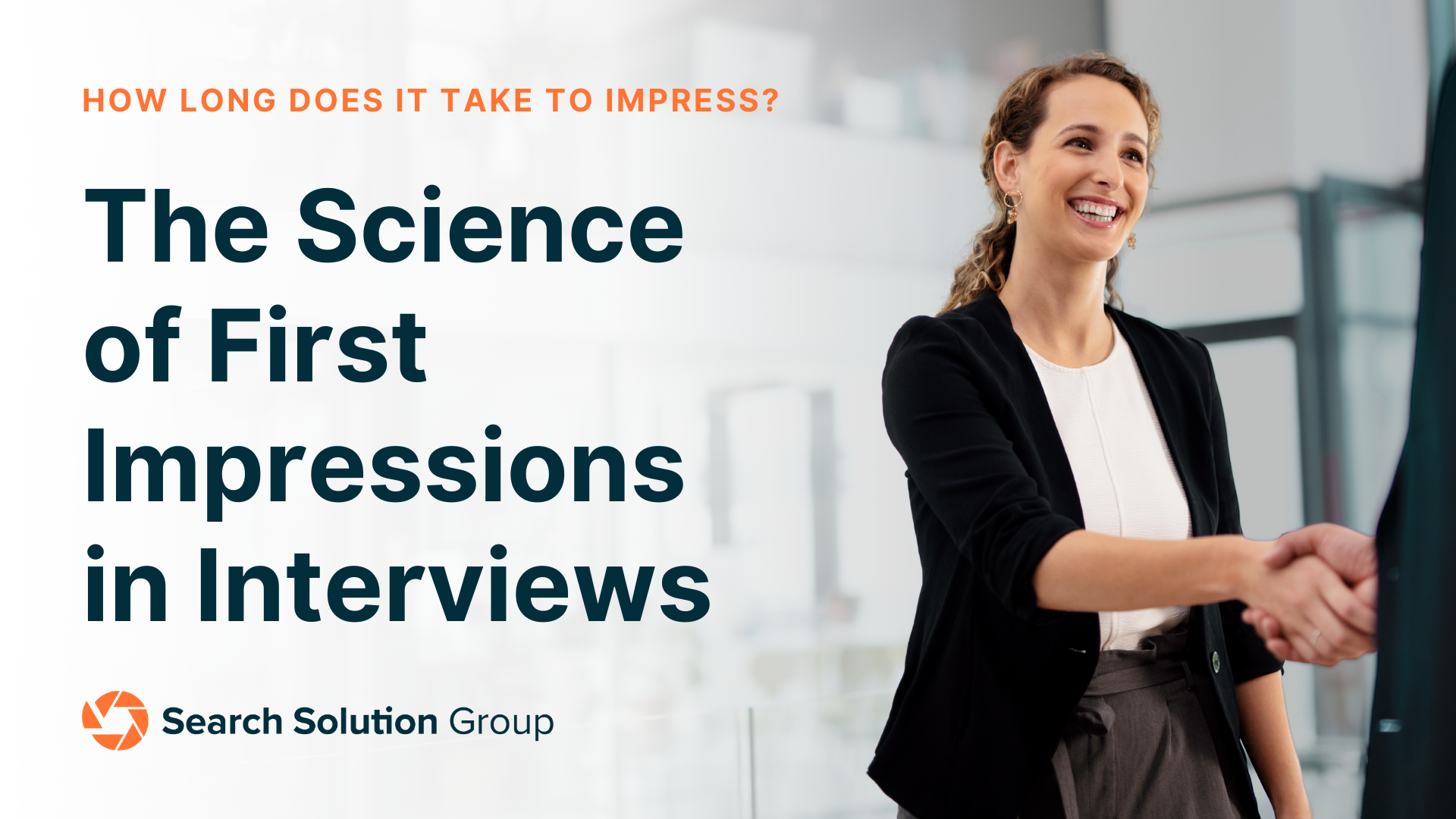In the time it takes to shake hands or say hello, your interviewer has already made a judgment about you. Studies reveal that it takes just seven seconds to form a lasting impression.
In an interview, that means you are being assessed before the first question is even asked. The way you walk into the room, greet your interviewer, and carry yourself in those opening moments sets the tone for everything that follows.
A confident entrance can make your answers land more effectively, while a shaky start can put you on the defensive. In a competitive job market, mastering these first few seconds is just as important as preparing your resume or practicing your responses, because interviews are not only about what you say but how you make people feel from the very start.
The Interview Starts Before You Speak
Your first impression is built on subtle cues, often before you speak a word:
- Posture & Presence: Walking in with confidence projects capability. Slouching suggests disinterest.
- Greeting: A handshake (or professional verbal equivalent) sets the tone for the interaction.
- Voice & Pace: A calm, steady delivery communicates confidence.
- Eye Contact & Micro-Expressions: A natural connection builds trust, while darting eyes signal distraction.
- Energy & Warmth: Enthusiasm makes you memorable, as long as it doesn’t feel forced.

First Impressions in Virtual and Phone Interviews
Not all interviews happen in person, but the science of first impressions still applies. In remote and phone settings, your environment, voice, and technical setup become substitutes for physical presence.
Video Interviews
- Eye Contact: Look into the camera lens rather than focusing only on the screen. This simulates face-to-face eye contact.
- Professional Environment: A clean, uncluttered background, good lighting, and minimal distractions show you’ve taken the meeting seriously.
- Technical Prep: Test your equipment, internet connection, and software in advance. Glitches may happen, but preparation minimizes their impact.
Phone Interviews
- Smile as You Speak: A smile actually changes the tone of your voice, making you sound warmer and more approachable.
- Control Your Pacing: Without visual cues, tone and rhythm become even more important. Avoid filler words like “um” and “like.”
- Have Notes Handy: Keep reference points nearby, but don’t read directly from them. Authenticity matters.
Even without physical presence, first impressions still form instantly. Within moments, your interviewer will decide whether you sound confident, prepared, and enthusiastic or distracted and unprepared.
Turning Answers Into Memorable Stories
Facts and bullet points are easy to forget, but stories stick. Instead of rattling off a list of accomplishments, bring your experiences to life with storytelling.
A structured method like STAR (Situation, Task, Action, Result) can help, but personality is what makes it memorable. When you weave in real challenges, decisions, and outcomes, interviewers see not just what you did, but who you are as a professional.
Building Connection During the Conversation
Strong first impressions are reinforced throughout the discussion:
- Listen actively and respond with curiosity by asking thoughtful follow-up questions.
- Read subtle cues from your interviewer and adjust your tone or detail level as needed.
- Strike a balance between confidence and authenticity, so you appear real and not overly rehearsed.
These small adjustments create a stronger sense of connection, which can be just as important as the content of your answers.
Making the Last Moments Count
The way you wrap up an interview can leave just as lasting an impression as how you began. Employers often recall the final moments of a conversation most clearly, so treat your close with the same care as your opening.
- Ask Smart Questions: Go beyond “What does success look like in this role?” and dig deeper. For example, “What challenges is the team currently focused on solving, and how would this role contribute?”
- Deliver a Memorable Thank-You: A simple but heartfelt thank-you reinforces professionalism.
- Exit with Energy: Leave with the same poise and confidence you started with. Stand tall, maintain eye contact, and end the interaction on a positive note.
Following Up the Right Way
A thoughtful follow-up helps solidify the impression you’ve made:
- Skip the generic thank-you email.
- Reference a specific topic or idea you discussed to show engagement.
- Share a relevant resource or insight that connects back to the conversation.
- Reinforce your enthusiasm without sounding repetitive.
This extra step not only shows professionalism but also keeps you top of mind.
Beyond the First Impression
Yes, the first seven seconds are critical, but they don’t tell the whole story. Interviews are marathons, not sprints. A great first impression creates momentum, but it’s the substance of your answers, the way you connect, and your ability to close strongly that carry you to the finish line.
The best candidates know how to balance both the science of creating an immediate impression and the art of sustaining it throughout the conversation.
Your Next Interview Starts Now
Remember: “Interviews aren’t won in the Q&A, they’re often won in the doorway.”
The seven-second rule is a powerful reminder that how you enter matters. Practice your introduction, role-play your opening moments with a friend, or record yourself to see how you come across. Small adjustments can have a big impact on how interviewers perceive you.
For more interview tips and career guidance, explore Search Solution Group. Our team is dedicated to helping professionals prepare with confidence and connect with the right opportunities.





